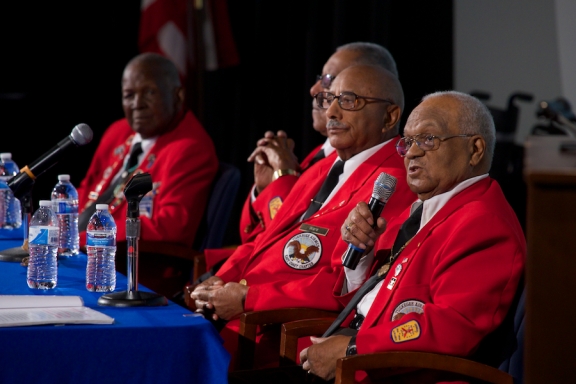By: Heather Van Allen & Jeffrey Worthington
A great way to enhance your experience in learning about history—while making it fun, too—is to visit a museum. Several American WWII museums dot the States and offer various options for learning about the war in ways that go beyond what any text book can provide. Highlighted below are a few locations in different parts of the country for you to consider.
National WWII Memorial, Washington, D.C.

The National WWII Memorial website says: “The Second World War is the only 20th Century event commemorated on the National Mall’s central axis.” Operated by the National Park Service, the memorial “honors the 16 million who served in the armed forces of the U.S., the more than 400,000 who died, and all who supported the war effort from home.”
The memorial is beautifully designed with a waterfall cascading over the bold stars representing our fallen WWII servicemen and women. Each state is also represented with a tall pillar and a permanent decorative wreath. Almost daily you will often find WWII veterans or their family members being photographed in front of their state’s pillar.
The website also features the World War II Registry, which electronically lists the names of Americans who contributed to the war effort.
For more information about visiting the WWII Memorial, visit www.nps.gov/nwwm
The National WWII Museum, New Orleans, LA
The exhibits of the National WWII Museum allow visitors to “experience the war through the eyes of the men and women who lived it,” highlighting the world leaders as well as the everyday contributors.
Palm Springs Air Museum, Palm Springs, Calif.
The Palm Springs Air Museum houses one of the largest collections of flyable WWII aircraft in the world. Currently, many of the volunteer docents available to give museum tours and answer visitors’ questions are WWII veterans.
National Museum of the Pacific War, Fredericksburg, Texas
The mission of the National Museum of the Pacific War is, “preserve, teach, interpret, and honor. …To teach present and future generations the history of the Pacific War and to honor Admiral Nimitz and all who served in that war.”
Dedicated exclusively to telling the story of the Pacific Theater battles of World War II, the museum includes the George Bush Gallery, Admiral Nimitz Museum, Pacific Combat Zone, Plaza of Presidents, Memorial Courtyard, Japanese Garden of Peace, and the Nimitz Education and Research Center (opening soon).
While this is just a sampling, the Museum & Memorial Guide, at military.com, offers a list of WWII Museums and Memorials located in several states in the U.S., including Alaska and Hawaii.
Tips for Planning a Trip to a WWII Museum
Look in your local area. Consider visiting a museum or memorial near your home to make planning and traveling the easiest. It may just be a matter of a car ride and a day trip.
Contact the museum before you travel. Visit the website for the museum and call to verify that the attraction is open for business. Open dates and hours vary from museum to museum, and some operate on seasonal schedules and close during certain parts of the year.
Work a stop into a family trip. Is your family already planning an out-of-town vacation? Check in advance to see if there is a WWII museum or memorial near your destination. Ask your parents to consider taking your family to visit the attraction while you are on your trip.
Suggest a school field trip. Who knows? Your history teacher may still be deciding on field trip options. Send a hint his or her way that a visit to a WWII museum or memorial in your area might be a fun, as well as educational, experience for your class.

























